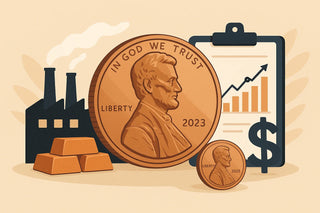At first glance, the humble penny might seem like an insignificant coin — just one cent, lightweight, often ignored. But behind this tiny coin lies a surprising economic puzzle that affects taxpayers, federal budgeting, and national debate on monetary policy. So, how much does it really cost to make a penny in the United States?
The Real Cost of Making a Penny
According to the most recent data from the U.S. Mint, it costs over 2 cents to produce a single 1-cent coin. That’s right — the cost to manufacture a penny is more than double its face value.
| Year | Cost to Make a Penny | Face Value | Net Loss per Penny | Total Annual Loss (Estimate) |
|---|---|---|---|---|
| 2023 | $0.0273 | $0.01 | $0.0173 | ~$87 million (3.2B coins) |
| 2022 | $0.0265 | $0.01 | $0.0165 | ~$82 million |
| 2021 | $0.024 | $0.01 | $0.014 | ~$70 million |
This means that every penny minted increases the deficit of the Mint's circulating coin program, which is self-funded through seigniorage (the difference between the value of money and the cost to produce it).
Why Is It So Expensive?
Several factors contribute to the high cost of producing a penny:
1. Material Costs
Modern pennies are made of 97.5% zinc and 2.5% copper, a composition adopted in 1982 to cut costs. However, commodity prices for both zinc and copper have risen over the years, making even this cheaper composition expensive.
2. Manufacturing and Distribution
The process of minting involves:
-
Blank production (turning metal coils into discs)
-
Striking the coin
-
Quality inspection
-
Distribution to Federal Reserve Banks
Each of these steps adds labor, energy, and logistical costs.
3. Volume of Production
Because pennies are still heavily circulated, the U.S. Mint produces billions each year. Even a slight increase in production cost multiplies into millions of dollars in losses.
Should We Get Rid of the Penny?
This ongoing cost has fueled national debate for years: Should the U.S. eliminate the penny altogether?
Arguments For Eliminating the Penny:
-
Cost Savings: Eliminating the penny could save taxpayers up to $90 million annually.
-
Time Efficiency: Pennies slow down transactions, leading to lost productivity.
-
Lack of Purchasing Power: A single penny buys nothing on its own anymore.
-
Environmental Impact: Mining zinc and copper has a significant environmental footprint.
Arguments Against Eliminating the Penny:
-
Price Rounding Concerns: Critics argue that removing the penny would lead to retailers rounding prices up.
-
Charity Impact: Penny donation drives (like at checkout counters) would disappear.
-
Tradition and Symbolism: The penny features Abraham Lincoln and has historical value to many Americans.
Other Countries Have Done It
Countries like Canada, Australia, and New Zealand have already eliminated their lowest denomination coins, rounding cash transactions to the nearest five cents without major issues. Canada phased out its penny in 2013 and now saves millions each year.
What Could Replace the Penny?
If the penny were eliminated, all cash transactions would be rounded to the nearest five cents, while non-cash (card, digital) transactions would remain exact. The nickel, which also costs more than its face value to produce, would likely become the new lowest denomination unless redesign efforts are made.
For more on how coins lose or retain value over time, check out our Compound Interest Calculator.
What Can You Do With Your Pennies?
If you’ve got jars of pennies sitting at home, you’re not alone. But what should you do with them?
-
Use them at coin-counting machines (some banks offer free services)
-
Donate to local charities or schools
-
Save for fun coin-collecting activities with kids or grandkids
-
Start a savings habit—even pennies add up over time! Try this 30-Day Savings Challenge.
Table: Summary – Should the Penny Stay or Go?
| Argument | Pro-Penny | Anti-Penny |
|---|---|---|
| Economic Cost | Tradition over cost | ~$90 million in losses annually |
| Environmental | Sentimental metal value | High environmental cost of production |
| Usability | Widely circulated | Slows down transactions |
| International Trend | Keeps U.S. "unique" | Most countries have moved on |
How This Affects the Bigger Picture
The issue of penny production is symbolic of a larger question: Are we clinging to outdated financial practices at the cost of efficiency? With digital transactions rapidly overtaking cash, it's time to ask whether it's worth continuing the production of coins that cost more than they’re worth.
For families looking to manage finances wisely, focusing on practical ways to cut unnecessary costs, build long-term habits, and understand the value of money is key. Explore our guide on the Best Way to Avoid Running Out of Money Too Fast for more actionable insights.
Frequently Asked Questions (FAQ)
Q: Why does it cost more than one cent to make a penny?
A: Rising metal prices (zinc and copper), labor, manufacturing, and distribution costs push the production cost of a penny to over 2.7 cents.
Q: Is the U.S. planning to eliminate the penny?
A: While there have been discussions and legislative proposals, no formal plans are currently in place.
Q: What happens to transactions if the penny is eliminated?
A: Cash transactions would be rounded to the nearest five cents. Electronic payments would not be affected.
Q: Are any coins profitable to make?
A: Yes, higher denomination coins like quarters and dollar coins usually cost less to produce than their face value, making them profitable.
Q: Can pennies still be used if they stop being made?
A: Yes. If discontinued, they would still be legal tender for years to come.
